Agilent Technologies 6000 User Manual
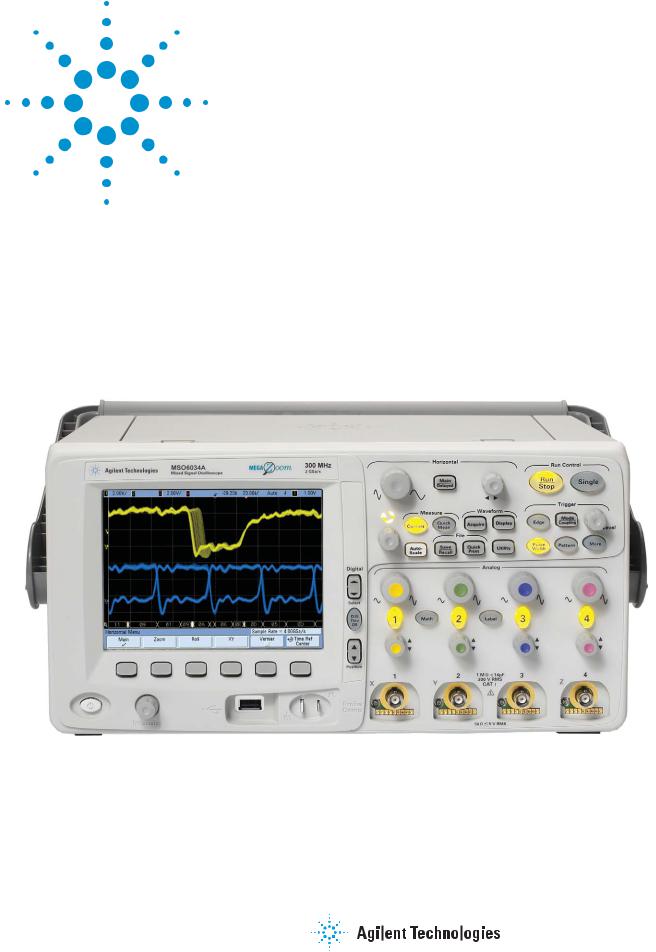
Agilent Technologies InfiniiVision
6000 Series Oscilloscopes
Data Sheet
Engineered for the best signal visibility
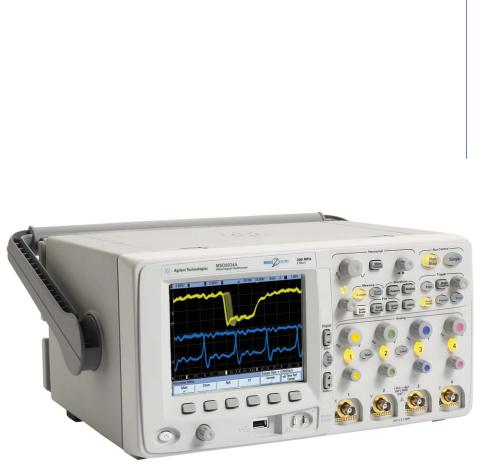
If you haven’t purchased an Agilent scope lately, why should you consider one now?
Agilent has been the fastest growing oscilloscope supplier since 1997 (source:
Wonder why? Agilent engineers developed the InfiniiVision 6000 Series with advanced technology that will allow you to see more subtle signal detail and more infrequent events than any other scope on the market. See the InfiniiVision 6000 Series oscilloscope— the industry’s best for signal viewing.
There is no better way to experience the superiority of the InfiniiVision 6000 Series scopes than to see it.
Contact Agilent today to request an evaluation.
Or visit: www.agilent.com/find/mso6000
The InfiniiVision 6000 Series offers bandwidths up to 1 GHz. Each model, equipped with a 6.3” XGA LCD display, comes in
a whisper-quiet package that weighs only 11 pounds.
Model |
Bandwidth |
Sample rate |
Memory |
Scope channels |
Digital channels |
Update rate |
|
DSO6012A |
|
|
|
2 |
|
|
|
DSO6014A |
100 MHz |
2 GSa/s |
8 Mpts |
4 |
|
|
|
MSO6012A |
2 |
16 |
|
||||
|
|
|
|
||||
|
|
|
|
|
|
||
MSO6014A |
|
|
|
4 |
|
||
|
|
|
|
|
|||
|
|
|
|
|
|
|
|
DSO6032A |
|
|
|
2 |
|
|
|
|
|
|
|
|
|
|
|
DSO6034A |
300 MHz |
2 GSa/s |
8 Mpts |
4 |
|
Up to 100,000 |
|
MSO6032A |
2 |
16 |
deep-memory waveforms |
||||
|
|
|
|||||
MSO6034A |
|
|
|
4 |
per second, even with |
||
|
|
|
|
||||
DSO6052A |
|
|
|
2 |
|
deep memory, digital |
|
DSO6054A |
500 MHz |
4 GSa/s |
8 Mpts |
4 |
|
channels and serial |
|
|
|
|
decode turned on. |
||||
MSO6052A |
2 |
16 |
|||||
|
|
|
|||||
|
|
|
|
|
|
||
MSO6054A |
|
|
|
4 |
|
||
|
|
|
|
|
|||
|
|
|
|
|
|
|
|
DSO6102A |
|
|
|
2 |
|
|
|
|
|
|
|
|
|
|
|
DSO6104A |
1 GHz |
4 GSa/s |
8 Mpts |
4 |
|
|
|
MSO6102A |
2 |
16 |
|
||||
|
|
|
|
||||
MSO6104A |
|
|
|
4 |
|
||
|
|
|
|
|
Choose from sixteen InfiniiVision 6000 Series models. Agilent provides an easy 5-minute DSO-to-MSO upgrade kit for
previously purchased 6000 Series DSOs.
2

What gives the InfiniiVision 6000 Series the best signal visibility?
1. High resolution
Oscilloscopes are visual tools and high-resolution screens make the product better. High resolution displays have become increasingly important as general purpose scopes need to display digital and serial signals in addition to traditional scope channels.
View up to 20 channels simultaneously with serial protocol. See subtle signal detail with up to 256 levels of intensity.
2. Fastest architecture
See a display more representative of the actual signals under test than with any other scope. The InfiniiVision 6000 Series shows jitter, infrequent events, and subtle signal detail that other scopes miss. Turn knobs and the instrument responds instantly and effortlessly. Need to also view digital channels? The instrument stays responsive. Decoding serial packets? Offering the industry’s only hardware-acceler- ated serial bus decode, Agilent’s InfiniiVision series delivers serial debug without compromising analog measurements.
InfiniiVision scopes incorporate acquisition memory, waveform processing, and display memory in an advanced 0.13 µ ASIC. This patented 3rd generation technology, known as MegaZoom III, delivers up to 100,000 waveforms (acquisitions) per second with responsive deep memory always available.
3. Insightful applications
Customize your general purpose scope. A wide range of application packages provide meaningful insight into your application-specific problems. (See pages 8-9 and 13-14 for more detail.)
Serial with hardware-accelerated decode |
|
|
|
|
|
|
|||
• |
I2C, SPI |
• |
RS-232/UART |
|
• |
Segmented memory |
|
• |
Vector signal analysis |
|
|
||||||||
• |
CAN/LIN |
• |
FlexRay |
|
• |
DSO/MSO offline analysis |
|
• |
Core-assisted FPGA debug |
|
|
|
|
|
• |
Power measurement |
|
• |
Secure environment |
Battery option |
|
|
|
|
|
|
|
|
|
3

Your design has analog, digital and serial signals ... shouldn’t your scope?
Analog: Up to 1 GHz bandwidth and up to 4 GSa/s sample rate
The InfiniiVision 6000 Series scope channels provide faster identification of your most elusive problems –
Revolutionary high-resolution display. Engineered with an XGA display and 256 levels of intensity grading, see a precise representation of the analog characteristics of the signals you’re testing. Equipped with the industry’s fastest uncomprimised update rate at 100,000 waveforms/ sec update rate, you’ll capture critical signal detail and see infrequent events that traditional scopes miss.
MegaZoom III technology. MegaZoom III responsive deep memory captures long, non-repeating signals and maintains high sample rates, allowing you to quickly zoom in on areas of interest. Sample rate and memory depth go hand-in-hand. Deep memory in oscilloscopes sustains a high sample rate over longer time spans.
Digital: 16 digital timing channels with mixed signal triggering
Capture a mix of analog or digital signals. Compare multiple cycles of digital signals with slower analog signals –
16 high-speed timing channels with up to 2 GSa/s deep memory. Use the timing
channels to evaluate control signal relationship. Or capture and view data buses up to 16 bits wide. Trigger on and display individual signals or bus waveforms in hex or binary.
Mixed signal trigger.
Trigger across any combination of analog and digital signals simultaneously. See precise analog measurements timed with exact digital content, all in one box.
Applications for digital channels.
Designing with Altera or Xilinx FPGAs? Use the FPGA dynamic probe for rapid internal FPGA measurements. Using I2C, SPI, or RS-232? Use the analog or digital signals from a 4-channe model to acquire and decode these serial buses.
Serial: Hardware-accelerated decode and trigger for I2C, SPI, RS-232, CAN, LIN and FlexRay
Capture long streams of serial data and gain fast insight into your problems. Agilent 6000 Series oscilloscopes provide the best serial protocol capabilities in their class
Serial bus triggering and decoding.
Display responsive, on-screen decode of serial bus traffic. Isolate specific events with pinpoint accuracy. Show decode to validate serial bus activity in real time.
Quickly find infrequent errors.
Hardware-accelerated decoding increases your probability of capturing elusive events. Agilent oscilloscopes can help you catch that intermittent problem before it becomes an intermitten customer complaint or quality concern.
Easily capture enough serial data to see all of the details.
Use deep memory to capture serial data stream over a long period of time.
4

Other useful features
High resolution mode. Offers up to 12 bits of vertical resolution in real-time, single-shot mode. This is accomplished by serially filtering sequential data points and mapping the filtered results to the display when operating at time base settings greater than 10-μs/div.
Help is at your fingertips. An embedded help system – available in 11 languages
– gives you quick answers if you don’t understand a feature. Simply press and hold the corresponding front-panel key, and a screen pops up to explain its function.
Waveform math with FFT. Analysis functions include subtract, multiply, integrate, square root, and differentiate, as well as fast Fourier transforms (FFT).
Peak detect. 250 ps on 500-MHz and 1-GHz models, 500 ps on 350-MHz models and 1 ns on 100-MHz models helps you find narrow glitches.
AutoProbe interface. Automatically sets probe attenuation factors and provides power for selected active probes, including the award-winning 1130A 1.5-GHz InfiniiMax differential active probe and 1156A 1.5-GHz single-ended active probe systems.
5-digit hardware counter. Measures frequency up to the bandwidth of the scope.
Trig Out and Reference Clock In/Out.
Provides an easy way to synchronize your scope to other instruments. Use the Trig Out port to connect your scope to a frequency counter for more accurate frequency measurements or to cross trigger other instruments.
Autoscale. Displays all analog and digital active signals, and automatically sets the vertical, horizontal and trigger controls.
23 automatic measurements with Quick-
Meas. Pressing [QuickMeas] brings up the last four automated measurements selected. Cursors automatically track the most recently selected measurement.
Analog HDTV/EDTV trigger. The 6000 Series comes standard with analog HDTV/ EDTV triggering for standards like 1080i, 1080p, 720p and 480p as well as standard video triggering on any line within a field, all lines, all fields and odd or even fields for
NTSC, SECAM, PAL and PAL-M video signals.
Bus mode display (on MSO models).
Quick and easy read-out of hexadecimal or binary representation of logic signals.
Easy software upgrades. System software is stored in flash ROM that can be upgraded from the scope’s built-in USB port or LAN. You can find the latest system and IntuiLink software at: www.agilent.com/find/mso6000sw
Press and hold a key for instant help.
FFT allows you to view the spectral content of this clock signal.
Digital signals can be displayed individually or as overlayed bus values.
5
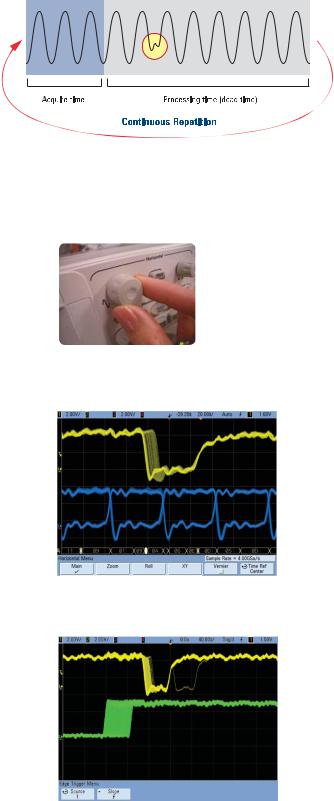
Why does a fast update rate matter?
While bandwidth, sample rate and memory depth are key criteria for deciding which scope to purchase, an equally important characteristic is update rate.
What is update rate?
Update rate is how many waveforms acquisitions per seconds you scope can acquire, process, and display. Oscilloscope “dead-time” is the time it takes for a scope to process and then display an acquired waveform before re-arming it’s triggering for the next acquisition. For traditional scopes, this time is often orders of magnitude greater than acquisition time on fast time-per-division settings.
If a glitch occurs during the scope’s dead-time, it won’t be captured. The key to improving the probability of capturing a signal anomaly during the scope acquisition time is to minimize dead-time.
Oscilloscope vendors usually specify what their scope’s “best-case” waveform update rates are. Some scope architectures suffer from factors that can seriously degrade the “best-case” update rates spec. Agilent’s 6000 Series architecture delivers the world’s fastest update rate when using:
• |
Analog channels |
• |
Analog and digital |
• |
Deep memory |
• |
Serial decode |
Why is update rate important?
1.Responsiveness. If you rotate the timebase control, you expect the oscilloscope to respond immediately – not seconds later after the scope finishes processing data.
2.Signal detail. Fast waveform update rates improve the display quality of the waveform that you see on screen.
3.Certainty. Fast waveform update rates improve the scope’s probability of capturing random and infrequent events.
Update rates directly affect a scope probability of capturing and displaying infrequent and random events. Slow update rates will cause a scope to miss subtle or infrequent signal details.
Improves instrument responsiveness
Improves scope display quality
Improves probability of capturing infrequent events
6
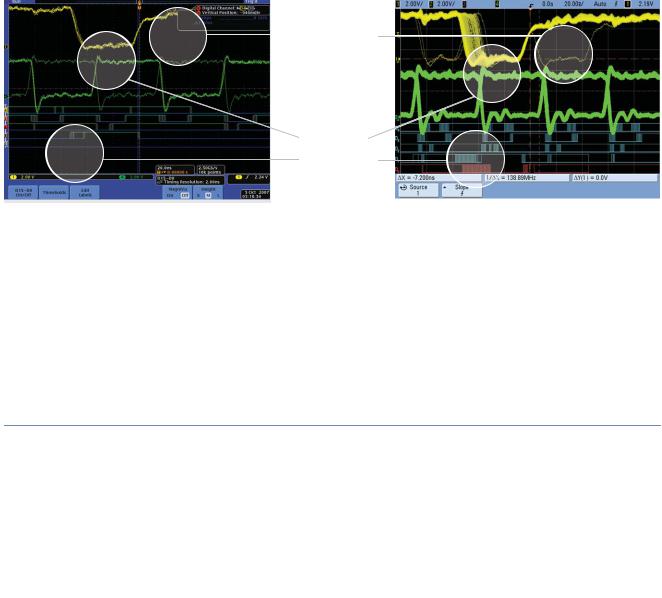
How update rate affects signal visibility
Capturing random and infrequent events on an oscilloscope is all about statistical probabilities. The key to improving the probability of capturing a signal anomaly is to minimize dead-time and take more pictures of the signal in a given timeframe. Here is an example with Tek and Agilent scopes both connected to a target with a glitch that occurs 25 times per second.
? |
? |
|
Infrequent |
|
|
||
|
|
signal activity |
|
|
|
|
? |
Critical |
signal jitter |
|
|
|
Tek MSO4104
•Product data sheet: 35,000 waveforms per second.
•Update rate = 18 waveforms per second with
10 Mpts and digital channels turned on. Resulting measurement shown.
•Probability of capturing the infrequent glitch = 0.09% after running for 10 seconds.
•Average time to capture just one glitch = 128 minutes.
Agilent MSO6104A
•Product data sheet: 100,000 waveforms per second.
•Update rate = 95,000 waveforms per second with auto memory and digital channels turned on. Resulting measurement shown.
•Probability of capturing the infrequent glitch = 99% after running for 10 seconds.
•Average time to capture just one glitch = 1.5 seconds.
|
|
Memory* |
|
Scope settings |
|
Measured update rates |
||||
|
|
Tek |
Timebase setting |
Digital Channels |
Serial Decode |
TEK MSO4104A** |
LeCroy WR 104Xi |
Agilent MSO6104A |
|
|
Initial setup |
|
|
|
|
|
|
|
|
|
|
10 |
Kpts |
20 ns/div |
- |
- |
55,000 |
27 |
95,000 |
|
||
Change timebase |
10 |
Kpts |
10 ns/div |
- |
- |
2,700 |
27 |
95,000 |
|
|
Add digital channels |
10 |
Kpts |
20 ns/div |
On |
- |
125 |
27 |
95,000 |
|
|
Increase memory setting |
10 |
Mpts |
20 ns/div |
On |
- |
35 |
27 |
95,000 |
|
|
Turn on serial decode |
|
|
|
|
|
|
|
|
|
|
10 |
Mpts |
20 ns/div |
On |
On |
0.2 |
25 |
95,000 |
|
||
|
|
|
|
|
|
|
|
|
|
|
* Agilent and LeCroy memory depth selection was automatically selected. Memory depth = display window times sample rate with up to 8 Mpts for Agilent. ** Tek measurements taken with version 2.13 firmware.
Seeing subtle signal detail and infrequent events requires a scope with fast waveform update rates. Don’t take a scope vendor’s banner waveform update rate specification at face value. Test it yourself. It’s actually pretty easy to characterize a scope’s update rate. Run a moderately fast signal (e.g. 50 Mhz) into a scope channel. Measure the scope’s average trigger output signal frequency. This is your scope’s update rate for the specified timebase setting. Test the update rate of the scope under various setup conditions. Setup conditions that Agilent suggests varying include timebase range, memory depth, and number of channels, including analog, digital, as well as channels assigned for serial decoding.
7
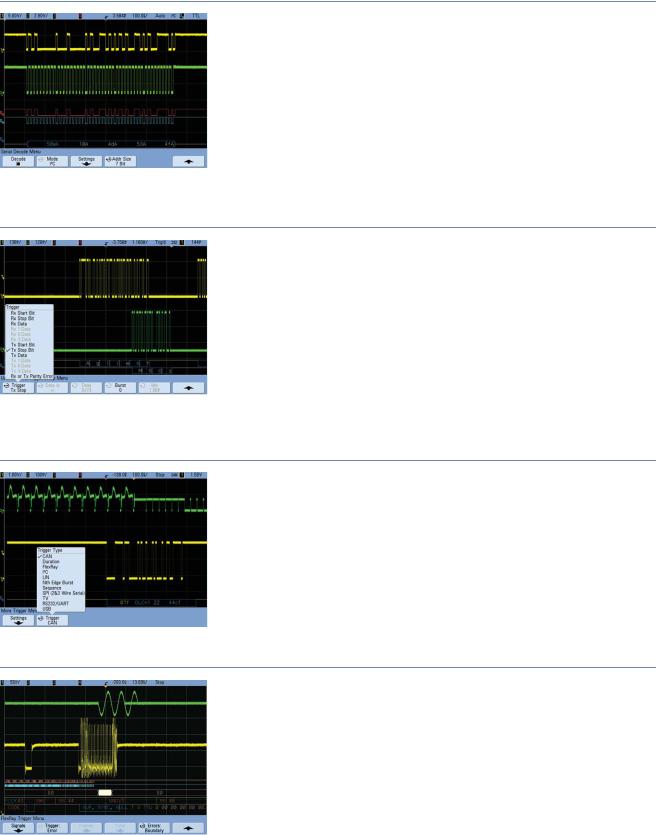
Software applications
I2C/SPI serial trigger and decode (N5423A or Option LSS on new scope purchases)
This application displays real-time timealigned decode of I2C and SPI serial buses. Hardware-accelerated decode means the scope stays responsive and fast.
View on-screen serial decode of an I2C packet.
This application requires a 4-channel DSO or 4-channel MSO and can use any combinatio of the scope or logic acquisition channels.
For more information:
www.agilent.com/find/I2C-SPI
Trigger on and decode RS-232/UART transmission.
RS-232/UART serial decode and trigger (N5457A or Option 232 on new scope purchases)
Does your design include RS-232 or another type of UART? This application eliminates the need to manually decode bus traffic. Using data captured on the scope or logic channels, the application lets you easily view the information sent over a RS-232 or other UART serial bus.
Display real-time time-aligned decode of transmit and receive lines. The application also enables triggering on RS-232/UART conditions.
This application requires a 4-channel DSO or 4-channel MSO and can use any combination of the scope or logic acquisition channels.
For more information:
www.agilent.com/find/RS-232
CAN/LIN triggering and decode (N5424A or Option AMS on new scope purchases)
Trigger on and decode serially transmitted data based on CAN and LIN protocols. This application not only provides triggering on complex serial signals, but it also provides unique hardwareaccelerated capabilities. Hardware-accelerated triggering and decode means the scope stays responsive and fast.
This application requires a 4-channel DSO or 4-channel MSO and can use any combination of scope or logic acquisition channels.
For more information: www.agilent.com/find/CAN-LIN
Trigger on and decode CAN serial packets.
FlexRay triggering and decode (N5432A or Option FRS on new scope purchases)
FlexRay protocol is based on time-triggered and deterministic architecture. Agilent’s FlexRay solution for the 6000 Series mixed signal oscilloscopes offers a robust set of FlexRay frame, slot, and error triggering, including the ability to trigger on specific FlexRay communications qualified on base-cycle and cycle-repetition. This solution combines an Agilent 6000 Series mixed signal oscilloscope (MSO) with an Agilent VPT 1000 vehicle protocol tester for FlexRay protocol analyzer.
This application requires a 4-channel MSO.
For more information: www.agilent.com/find/flexray
See mixed signal measurements in a
FlexRay system using an MSO.
8
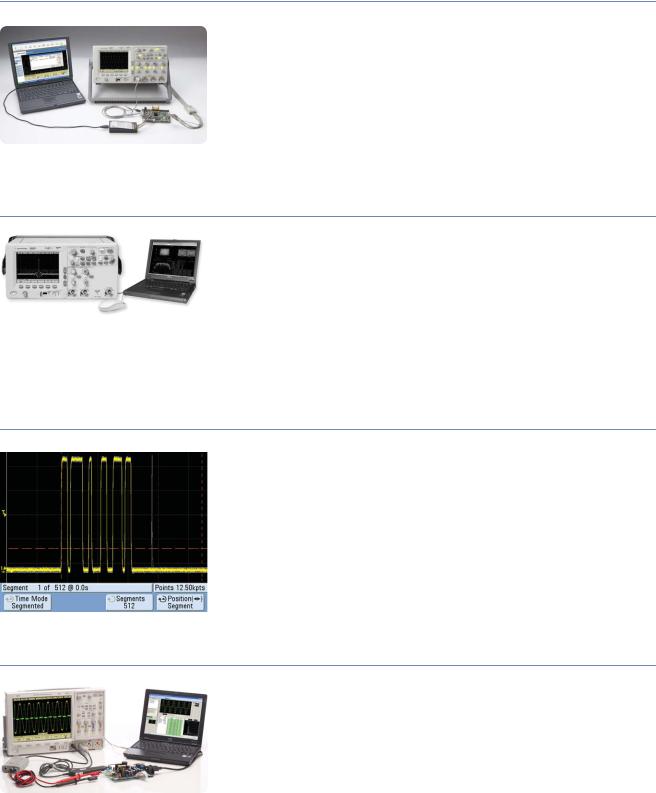
Software applications
Debug and validate your FPGA designs faster and more effectively with the FPGA dynamic probe and an Agilent MSO.
FPGA dynamic probe application (N5406A for Xilinx, N5434A for Altera)
Give your MSO internal FPGA visibility. Agilent’s MSO FPGA dynamic probe provides internal FPGA visibility and quick instrument setup using an innovative core-assisted debug approach. Measurement tasks that previously took hours can be done in a few mouse clicks. In a few seconds, easily measure a different set of internal signals without changing your FPGA design.
This application works with all MSO models.
For more information:
www.agilent.com/find/6000-altera
www.agilent.com/find/6000-xilinx
Expand the capability of your scope with 89601A vector analysis software.
Vector signal analysis software (89601A)
Expand the measurement capability of your scope with the 89601A vector signal analysis software. This advanced DSP based software takes the digitized signal data provided by the scope and provides FFT based spectrum analysis and wide bandwidth digital modulation analysis for wireless communication signals like WCDMA and cdma2000, and wireless networking signals like 802.11 WiFi and 802.16 WiMaxTM.
Take advantage of the super wide bandwidth of your scope to capture and evaluate radar signals.
For more information: www.agilent.com/find/6000-vsa
Segmented memory (N5454A or Option SGM on new scope purchases)
Segmented memory optimizes available memory for data streams that have long dead times between activity. The application excels at analyzing signal activity associated with laser pulses, serial buses, and bursty signals such as radar. View an overlay of all signal segments, including MSO channels and serial decode, while highlighting the current segment. Quickly move between segments to view signal detail associated with a specific segment.
This application works with all DSO and MSO models.
For more information: www.agilent.com/find/segmented
Use segmented memory to optimize available memory.
Use your scope to quickly make and analyze power measurements.
Power application (U1881A)
Need to make power measurements with your scope? Agilent’s power application provides a full suite of power measurements that run on a PC connected to an InfiniiVision 6000 Series oscilloscope. Make more accurate power supply efficiency measurements by using an U1880A deskew fixture to deskew your voltage and current probes.
This application works with all DSO and MSO models.
For more information: www.agilent.com/find/power-app
9
